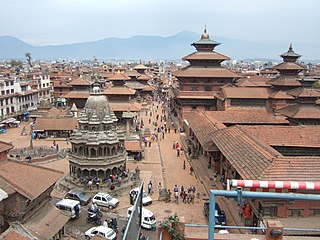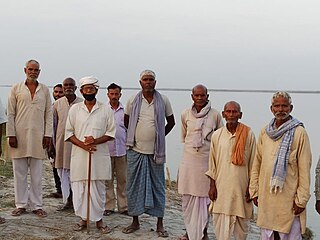Related Research Articles

Kathmandu, officially the Kathmandu Metropolitan City, is the seat of federal government and the most populous city in Nepal. As of the 2021 Nepal census, there were 845,767 inhabitants living in 105,649 households and approximately 4 million people in its surrounding agglomeration. It is located in the Kathmandu Valley, a large valley surrounded by hills in the high plateaus in central Nepal, at an altitude of 1,400 metres.

Nepal is a multi-ethnic, multiracial, multicultural, multi-religious, and multilingual country. The most spoken language is Nepali followed by several other ethnic languages.

The Kingdom of Nepal was a Hindu kingdom in South Asia, formed in 1768 by the expansion of the Gorkha Kingdom, which lasted until 2008 when the kingdom became the Federal Democratic Republic of Nepal. It was also known as the Gorkha Empire, or sometimes Asal Hindustan. Founded by King Prithvi Narayan Shah, a Gorkha monarch who claimed to be of Thakuri origin from chaubisi, it existed for 240 years until the abolition of the Nepalese monarchy in 2008. During this period, Nepal was formally under the rule of the Shah dynasty, which exercised varying degrees of power during the kingdom's existence.

Nepal, officially the Federal Democratic Republic of Nepal, is a landlocked country in South Asia. It is mainly situated in the Himalayas, but also includes parts of the Indo-Gangetic Plain. It borders the Tibet Autonomous Region of China to the north, and India to the south, east, and west, while it is narrowly separated from Bangladesh by the Siliguri Corridor, and from Bhutan by the Indian state of Sikkim. Nepal has a diverse geography, including fertile plains, subalpine forested hills, and eight of the world's ten tallest mountains, including Mount Everest, the highest point on Earth. Kathmandu is the nation's capital and the largest city. Nepal is a multi-ethnic, multi-lingual, multi-religious and multi-cultural state, with Nepali as the official language.

Mahendra Bir Bikram Shah Dev, was the ninth King of Nepal from 13 March 1955 until his death in 1972, which was due to a heart attack, as told in an interview by his personal physician Dr. Mrigendra Raj Pandey. Following the 1960 coup d'état, he established the party-less Panchayat system, which governed the country for 28 years until the introduction of multi-party democracy in 1990. During his reign, Nepal experienced a period of industrial, political and economic change which opened it to the rest of the world for the first time, after the 104-year-long reign of the Rana rulers, who kept the country under an isolationist policy, came to an end in 1951.

Newar is a Sino-Tibetan language spoken by the Newar people, the indigenous inhabitants of Nepal Mandala, which consists of the Kathmandu Valley and surrounding regions in Nepal. The language is known officialy in Nepal as Nepal Bhasa, a name that has been historically used for the language. The term "Newari" is also used to refer to the language, although the Indic -i suffix is considered inappropriate by some Newar speakers.

Lalitpur Metropolitan City, also known as Patan, Yala, and Manigal, is a metropolitan city and fourth most populous city of Nepal with 299,843 inhabitants living in 49,044 households per the 2021 census. It is located in the south-central part of Kathmandu Valley, a large valley in the high plateaus in central Nepal, at an altitude of 1,400 metres.
Indo-Pakistani Sign Language (IPSL) is the predominant sign language in the subcontinent of South Asia, used by at least 15 million deaf signers. As with many sign languages, it is difficult to estimate numbers with any certainty, as the Census of India does not list sign languages and most studies have focused on the north and urban areas. As of 2024, it is the most used sign language in the world, and Ethnologue ranks it as the 149th most "spoken" language in the world.
Kenyan Sign Language is a sign language is used by the deaf community in Kenya and Somalia. It is used by over half of Kenya's estimated 600,000 deaf population. There are some dialect differences between Kisumu, Mombasa and Somalia.

Madheshi people is a term used for several ethnic groups in Nepal living in the central and eastern Terai region of Nepal. It has also been used as a political pejorative term by the Pahari people of Nepal to refer to Nepalis with a non-Nepali language as their mother tongue, regardless of their place of birth or residence. The term Madheshi became a widely recognised name for Nepali citizens with an Indian cultural background only after 1990.

The Dhaka topi, or Nepali topi, is a traditional Nepali cloth hat which forms part of Nepalese national dress, and worn by men on celebrations.

Nepal Bhasa movement refers to the struggle for linguistic rights by Newar speakers in Nepal in the face of opposition from the government and hostile neighbors. The campaign aims to increase the use of Nepal Bhasa in the home, education, government and business. Despite a high level of development, Newar culture and language are both under threat.

Francis Maginn (1861–1918) was a Church of Ireland missionary who worked to improve living standards for the deaf community by promoting sign language and was one of the co-founders of the British Deaf Association.
Nepalese Sign Language or Nepali Sign Language (Nepali: नेपाली साङ्केतिक भाषा, romanized: Nēpālī Sāṅkētika Bhāṣā is the main sign language of Nepal. It is a partially standardized language based informally on the variety used in Kathmandu, with some input from varieties from Pokhara and elsewhere. As an indigenous sign language, it is not related to oral Nepali. The Nepali Constitution of 2015 specifically mentions the right to have education in Sign Language for the deaf. Likewise, the newly passed Disability Rights Act of 2072 BS defined language to include "spoken and sign languages and other forms of speechless language." in practice it is recognized by the Ministry of Education and the Ministry of Women, Children and Social Welfare, and is used in all schools for the deaf. In addition, there is legislation underway in Nepal which, in line with the UN Convention on the Rights of Persons with Disabilities which Nepal has ratified, should give Nepalese Sign Language equal status with the oral languages of the country.

Dhammalok Mahasthavir was a Nepalese Buddhist monk who worked to revive Theravada Buddhism in Nepal in the 1930s and 1940s. For this act, he was expelled from the country by the tyrannical Rana regime.
The National Deaf Federation Nepal is a non-governmental organization established and run as the umbrella organization for Nepal's various district and local deaf associations. Previously it was known as the National Federation of the Deaf and Hard of Hearing (NFDH). It is a member of the World Federation of the Deaf (WFD) and works as an advocate for deaf rights, as well as running a number of programs throughout the country to improve the lives of Nepal's deaf population.
The Nepali manual alphabet is fingerspelling devised for the Nepali alphabet-syllabary, Devanagari, to go with Nepalese Sign Language. It was developed by the Kathmandu Association of the Deaf (KAD), with support from UNICEF. Based loosely on the formulations in the American manual alphabet and International manual alphabet, only the forms for the letters अ, ब, म, and र can be said to derive directly from their Latin alphabet equivalent. All other letter finger-shapes are indigenous.

Karna Shakya is a Nepalese environmentalist, conservationist, hotel entrepreneur, writer and philanthropist. Shakya is a forester by academic qualification. He served as a wildlife officer and pioneered in establishing the first National Park in Nepal. He resigned from his government job, entered the tourism business in 1970, and now owns a chain of eco-friendly hotels in major touristic cities like Kathmandu, Pokhara, chitwan and Lumbini.

Martin Chautari is a non-profit organization in Kathmandu, Nepal established to foster public dialogue and contribute to discussions on current social issues such as democracy, development, civil liberties, and social justice.
South Korea's Deaf population began to come to prominence in recorded history in the late 19th century with the implementation of special education. Since then, they have gained government recognition and legal rights.
References
- ↑ "though was not recognized by Nepal's government until ten years later" p 289 in Erika Hoffmann-Dilloway (2011) Lending a hand: Competence through cooperation in Nepal's Deaf associations, Language in Society 40, 285–306.
- 1 2 Raghav Bir Joshi (1991) Nepal: A paradise for the deaf? Sign Language Studies 20: 161-168.
- ↑ P. Ross, and NK Devkota (1989). Nepali Sign Language Dictionary: The Welfare Society for the Hearing Impaired. Kathmandu: Shayogi Press